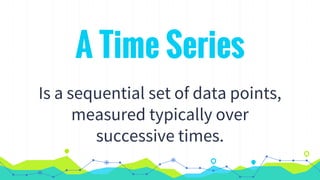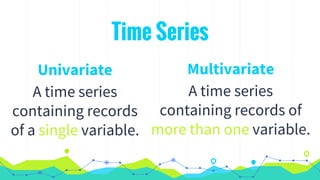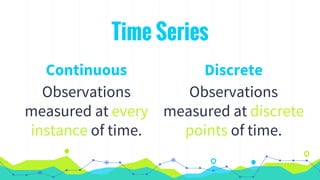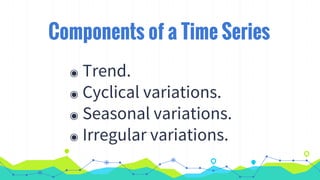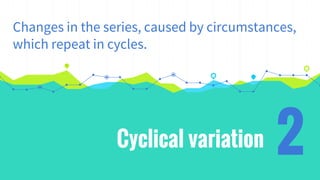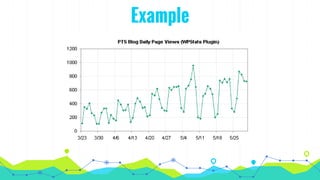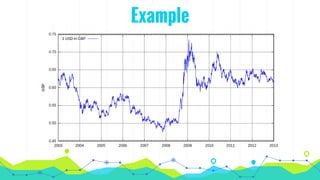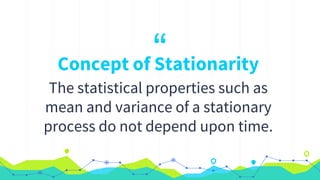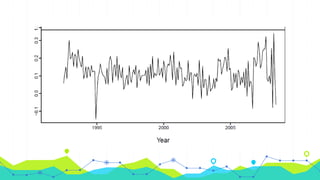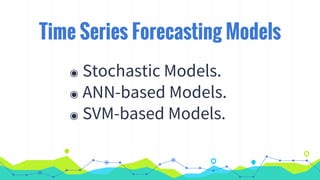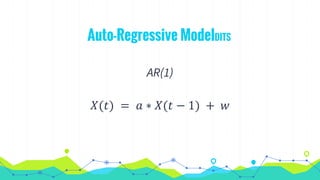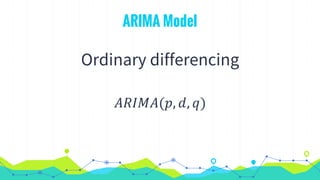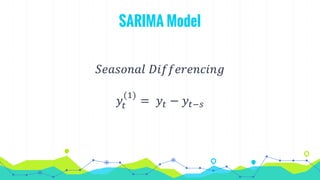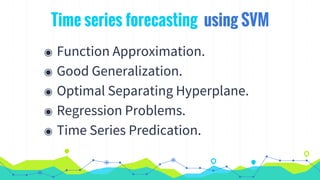Time series forecasting
- 2. A Time Series Is a sequential set of data points, measured typically over successive times.
- 3. Example
- 4. Time Series Univariate A time series containing records of a single variable. Multivariate A time series containing records of more than one variable.
- 5. Time Series Continuous Observations measured at every instance of time. Discrete Observations measured at discrete points of time.
- 6. Example
- 7. Components of a Time Series ◉ Trend. ◉ Cyclical variations. ◉ Seasonal variations. ◉ Irregular variations.
- 8. Trend The general tendency of a time series to increase, decrease or stagnate over a long period of time. 1
- 9. Example
- 10. Cyclical variation Changes in the series, caused by circumstances, which repeat in cycles. 2
- 11. Example
- 12. Seasonal variations Fluctuations within a year during the season. 3
- 13. Example
- 14. Irregular or random variations Caused by unpredictable influences, which are not regular and also do not repeat in a particular pattern. 4
- 15. Example
- 16. “Time Series Analysis The procedure of fitting a time series to a proper model.
- 17. “Concept of Stationarity The statistical properties such as mean and variance of a stationary process do not depend upon time.
- 18. “
- 19. “
- 20. “Time series Stationarity is a necessary condition for building a time series model that is useful for future forecasting.
- 21. Time Series Forecasting Models ◉ Stochastic Models. ◉ ANN-based Models. ◉ SVM-based Models.
- 22. Time series forecasting using Stochastic Models ◉ Auto-Regressive Model. ◉ Moving Average Model. ◉ ARMA Model. ◉ ARIMA Model. ◉ SARIMA Model.
- 23. Auto-Regressive ModelDITS AR(p) The feature value of a variable is assumed to be a linear combination of p past observations.
- 24. Auto-Regressive ModelDITS AR(1) 𝑋(𝑡) = 𝑎 ∗ 𝑋(𝑡 − 1) + 𝑤
- 26. ARMA Model 𝐴𝑅𝑀𝐴(𝑝, 𝑞) Combination of Two Models AR(p) MA(q)
- 29. ARIMA Model 𝑦𝑡 (1) = 𝑦𝑡 − 𝑦𝑡−1
- 30. ARIMA Model
- 31. ARIMA Model
- 32. SARIMA Model 𝑆𝑒𝑎𝑠𝑜𝑛𝑎𝑙 𝐷𝑖𝑓𝑓𝑒𝑟𝑒𝑛𝑐𝑖𝑛𝑔 𝑦𝑡 (1) = 𝑦𝑡 − 𝑦𝑡−𝑠
- 33. SARIMA Model
- 34. SARIMA Model
- 35. SARIMA Model
- 36. Time series forecasting using ANNs ◉ Universal functional approximators. ◉ Solve Nonlinear problems. ◉ Data Driven. ◉ Generalization. ◉ Tolerate noise in data.
- 37. Time series forecasting using ANNs
- 38. Time series forecasting using ANNs
- 39. Time series forecasting using SVM ◉ Function Approximation. ◉ Good Generalization. ◉ Optimal Separating Hyperplane. ◉ Regression Problems. ◉ Time Series Predication.
- 40. Time series forecasting using SVM
- 42. Comparison - Example Observed Stochastic ANN SVM
- 43. THANKS!

